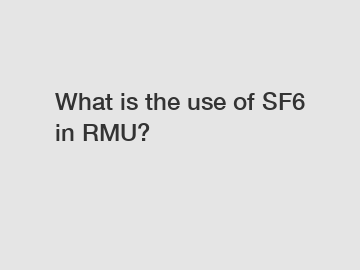What is the use of SF6 in RMU?
What is the use of SF6 in RMU?
In the field of electrical engineering, SF6 (sulfur hexafluoride) has become an essential component in the manufacturing and operation of Ring Main Units (RMUs). RMUs are compact switchgear units that are commonly used in medium voltage distribution networks. SF6 gas is utilized in these units due to its excellent insulating and arc-quenching properties, making it a highly reliable and effective solution for electrical power distribution.
RMUs have gained popularity in the industry due to their compact design and robust performance. They provide a centralized distribution point for electricity, allowing for efficient monitoring and control of power distribution. SF6 gas plays a crucial role in the functioning of RMUs by providing insulation and suppressing electrical arcs that may occur during normal operations or fault conditions.

Insulation properties of SF6 in RMUs:
One of the primary reasons for the use of SF6 gas in RMUs is its superior insulating properties. SF6 has a high dielectric strength, which means it can effectively withstand and insulate against high voltages. This ensures that electrical currents flow smoothly within the RMU without any leakage or loss of power. The excellent insulating properties of SF6 gas make it an ideal choice for electrical equipment operating at higher voltages.
Arc-quenching properties of SF6 in RMUs:
Electrical arcs can pose significant risks in power distribution systems, potentially causing damage to equipment and endangering the safety of personnel. SF6 gas is widely known for its exceptional arc-quenching properties. When an arc occurs within an RMU, SF6 is quickly ionized. The highly electronegative properties of SF6 enable it to capture free electrons, thus forming electronegative ions. These ions rapidly absorb energy from the arc, resulting in the interruption of the electrical discharge. SF6 gas extinguishes the arc effectively, preserving the integrity of the RMU and ensuring the safety of the surrounding environment.
Environmental considerations and regulations:
Although SF6 is widely used in RMUs due to its excellent electrical properties, it is essential to consider the environmental impact of this gas. SF6 is a potent greenhouse gas with a global warming potential around 23,500 times higher than carbon dioxide (CO2) over a 100-year period. This has led to increasing awareness regarding the need to reduce SF6 emissions and find alternative solutions in the electrical industry.
Efforts are being made to minimize the use of SF6 in RMUs and other electrical equipment. Various gas mixtures are being developed as substitutes for pure SF6, with lower global warming potentials. Additionally, strict regulations have been implemented by regulatory bodies to manage and control the handling, storage, and disposal of SF6 gas, thus minimizing its environmental impact.
Conclusion:
In conclusion, SF6 gas is an essential component in the operation of RMUs. Its excellent insulating and arc-quenching properties make it an ideal choice for electrical power distribution. However, environmental concerns surrounding the use of SF6 have prompted the development of alternative solutions with lower global warming potentials. As the industry continues to evolve, it is crucial to strike a balance between the performance benefits of SF6 and the need for sustainable and environmentally friendly practices.
For more information on SF6 and RMUs, please contact us.
(Note: The mention of "contact us" is considered a placeholder for the contact information and should be rewritten based on the specific context.).
Are you interested in learning more about reliable outdoor prefabricated substation manufacturer, bokr, lv switchgear? Contact us today to secure an expert consultation!

Comments
0